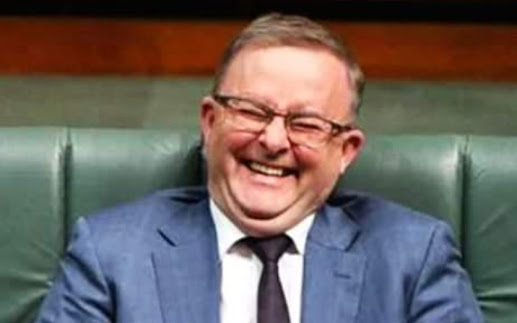A country's defence force should be focused on defending that country, not provoking perceived enemies. But looking at Australia’s most recent Defence Strategic Review, using phrases like “impactful projection” suggests something else entirely.
The $368 billion AUKUS deal manifests "projection" of Australian military forces more than 4000 kilometres away.
The handful of AUKUS nuclear submarines - when they eventually appear in some 10 years' time - are actually intended to be part of an overall United States military force in the South China Sea. , A handful of nuclear submarines only work if they are enmeshed with the US military, inevitably dragging Australian into US activities with its logical conclusion of eroding Australian sovereignty.
So there's that risk and at enormous expense to Australian taxpayers.
The argument that this somehow benefits Australia is thin, to say the least.
The arguments against the sense of the AUKUS deal are mounting up. The Albanese government has committed to acquiring 8 nuclear-powered submarines. The first 3-5 of these are meant to be Virginia-class submarines purchased from the US. The last 3-5 are supposed to be AUKUS SSN nuclear submarines built in Adelaide from a yet-to-be-finalised British design.
The first Australian-operated US Virginia-class submarine is planned to arrive in the early 2030s, with the next 7 online over the following 25 years.
On the US side, 5 nuclear submarines represents about 10 per cent of their total attack-class submarine fleet. It costs more than US$4.3 billion ($6.7 billion) and takes 6 years for the US to build a Virginia-class submarine. While the US has plans to build 2 submarines a year going forward, the current US industrial capacity is stretched to produce 1.2 boats a year.
Accordingly, the US is starting to wake up to the fact that, together with historical production factors, this is is likely to cause a deficiency over the next 10 years such that the US will be 20 boats short of its targeted fleet size. That’s exactly the same time in which Australia will be asking for its first submarines from the same production line.
In order to meet the combined need of the US Navy and the AUKUS deal, US production rates will have to increase from 1.2 boats a year to 2.2 boats a year. Yet there is no plan or spending commitment to make this production jump a reality.
Nonetheless, Australia has decided to give $3 billion to support US shipbuilding which, even if delivered, would go nowhere near to addressing the scale of the industrial shortfall.
To add to these concerns, the number of US attack submarines currently requiring maintenance is almost double the historical average, running at almost 37 per cent of their fleet. This significantly reduces their operational readiness.
Ultimately, quite apart from PM Albanese's fervent wish that it be otherwise at his meeting last week with President Joe Biden and Secretary of State Anthony Blinken he US will only approve transfer of their precious few nuclear submarines to Australia if it is in their interest. Whatever is said by President Joe Biden in 2023, by the early 2030s it is extremely hard to see how those in power will agree to any transfer of nuclear submarines to Australia, given its own shortfalls and needs.
Any final approval to transfer a nuclear submarine will require both a future US administration to approve and a future US congressional vote. Anyone watching US politics in 2023 would be brave to gamble on that playing out with any certainty in 2033. Meanwhile, Australia is spending billions on this pipedream.
Our projected budget spending on AUKUS submarines by the end of the 2032-33 financial year is $57.6 billion, all of which is lost without US political approval. That’s a hell of a gamble on a selfless vote from a Congress which seems to struggle to agree to even the basics of running its own government, approving supply and electing a Speaker. This debacle is on top of the $5 billion already wasted on not getting French submarines..
What a joke.
Assuming that, against all odds, the politics come good and the boats are delivered, what will be the military impact? Some time in the mid 2040s - at a time when relations with our Indo-Pacific neighbours is likely to be completely different - we might have, at most, maybe 5 Virginia-class nuclear submarines. The standard Virginia-class nuclear submarine has the capacity to carry up to 12 Tomahawk cruise missiles as their critical strike capacity, together with a complement of torpedoes.
Taking into account crew rotation, maintenance requirements and transit times, even with a maximum fleet of 8 nuclear submarines, the best-case scenario for 2054 will see 2-3 nuclear submarines at sea at any one time.
Doing the maths, that will result in 24 or maybe 36 Tomahawk missiles with 450 kilogram conventional warheads. (Australia has "promised" they won't be nuclear). Each such warhead is enough to destroy a moderate sized building or potentially sink a ship. Once these missiles are fired, the submarines then need to return to Australia to restock before they can return, weeks later, to any conflict.
So which brilliant strategist has convinced the Australian government that that it should spend $368 billion, with all the opportunity costs that brings for civil or even other military programs, to deliver 36 bombs to a fight? Scomo? Dutton? The lobbyists acting for the US military industry contractors? The guy on The Simpsons that convinces Springfield to invest in a monorail? Who? Remember that ths was decided well AFTER many years of Australian Department of Defence spending some 10 years begging for the French subs to replace the aged Collins Class subs that were to cost less than one seventh (and, in fact, we'd have already taken delivery of one had we proceeded with that "firm" contract).
To put it in perspective, that’s $368 billion for what is effectively less than the payload of a single B-52 bomber. Yet this is what the Australian public has been signed up to, and that’s in a “best-case” scenario for the war planners, where we actually get the boats. Viewed from this narrow military point of view, it is an obscene misallocation of national resources.
Or evidence of massive corruption.
Or both.
No matter how you look at this plan, it’s beyond a joke. We squander our taxpayers' money likes there's no tomorrow (or, maybe, that's the Pentacostal End of Times point), antagonise our neighbours, invite further escalation from China, all to deliver a highly speculative and marginal military asset to some other nation's future conflict. It’s the kind of project that only a man from marketing like former prime minister Scott Morrison could invent. Oh, that’s right: he did.
But somehow Albo thought it was a good idea. So much so that at his recent meeting with Biden he acted like Dickens' Oliver Twist holding out his porridge bowl..."Please Sir"...
Meanwhile, Albo is ignoring urgent and real risks at home and in our region, not least of which is climate change. While he has been loudly cheering on - if not begging for - obscene military expenditure as a supposed strategy allegedly to keep Australians "safe" (in reality, just heading towards Australia the US's 51st State and swelling the US weapons industry profits) his government has refused to release the, no doubt, terrifying report from the Office of National Intelligence about the security threat from climate change.
Imagine if we had $368 billion to spend on decarbonising our economy, strengthening our neighbour’s climate readiness and educating our children to be the best and brightest in the world. Imagine how much safer and more secure that would actually make us?
Oh, and I forgot to mention: EVEN IF we get the nuclear subs, Australia still doesn’t have a site for its nuclear waste.
For now, we are talking mostly medical nuclear waste – the South Australian town of Kimba was slated to take the waste following a decision by the former Coalition government – but the federal court upheld a challenge by the traditional owners. Labor accepted the court decision and the nuclear waste dump is not going ahead.
But that means we don’t have a nuclear waste dump, which is a problem, given that Australia is now part of the AUKUS nuclear submarine joke...oh I mean pact. But as the Greens senator David Shoebridge has probed under Senate estimates, there is no pathway as yet when it comes to disposing of that waste.
The government is looking at where to next. It has been a long time coming – this decision has been about 50 years in the making – but the government still needs to decide “the way forward”.
Timelines and processes will depend on the options moving forward. But at the moment, we have a so-called plan for nuclear submarines, but no plan on how to dispose of nuclear waste.
You gotta laugh...



Comments
Post a Comment